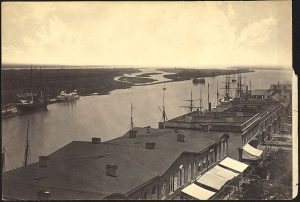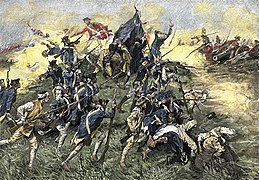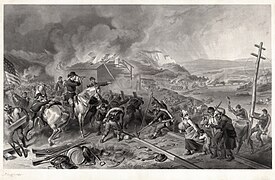Ghosts of Savannah, GA
Savannah, Georgia is one of the most haunted places in America. Its historical district is known for ghosts, spooky tours, and haunted places. Everything there, from the cobblestone streets to the hanging Spanish moss, has a dark tale behind it.

11 Places With Ghosts
- 432 Abercorn street
- Mercer Williams House
- The Willink House
- The Owens-Thomas House
- Colonial Park Cemetery
- The Moon River Brewing Company
- Hamilton-Turner Inn
- Marshall House
- Factor’s Walk
- Wright Square
- The Pirates’ House
The History of it All
In 1733, the gothic town of Savannah, Georgia was born. It went through many atrocities since it was founded, giving it a rich history of death and a current population of dark otherworldly sensations.
1778-1779
The line of grievances began on December 29th, 1778.
Just after Christmas, the British armies seized Savannah and held them under militia rule for months. Then nearly a year later, the colonists decided to win the city back. Accordingly, an army of five thousand men stormed Savannah and fought the British army stationed there. Although the colonists outnumbered the British, they began losing quickly. The attack was called off and they left Savannah and its citizens under Great Britain’s rule until the end of the Revolutionary War.

1796
What started as a small bakery fire quickly became a large-scale burn that scoured the city. The fire department at the time was not handled to combat such a large flame, and things got out of hand. So by the time the fire stopped of its own accord, two-thirds of the city had been reduced to a burnt husk.
1820
The 20s are never a good year, no matter what generation you’re in. For Savannah, GA, the year 1820 came with another large spread of fire and a large spread of disease.
Many were still alive who had seen the fire of 1796. On January 11th, 1820, a small fire started in a boarding house. It began rapidly spreading due to the drought they were undergoing. Within minutes the fire was burning the whole city, ninety-four total lots had buildings that were wrecked.
As if a wildfire wasn’t enough, that year a Yellow Fever epidemic hit. If someone catches Yellow Fever, it might as well be a death sentence. The disease ran its course in a week and 60% of people who caught the disease died. (Due to lack of medical care at that time). That year, exactly six hundred and sixty-six people died of Yellow Fever.
666.
Savannah might as well have been cursed.
1854
Less than forty years later, a second epidemic hit.
Many packed up and left Savannah–if they could afford to. Those who couldn’t quarantined and shut down their businesses. It was a ghost town. But even so, the disease still spread and in the end, over a thousand people died.
1864
There was another war in the United States, and Savannah was sieged again.
And once again it is around Christmas time. On December 22nd, 1864, the march to the sea ended in Savannah. General Sherman of the North led an army through the South, burning down cities as they went, with a destination in mind: Savannah.
However, many of the citizens left ahead of time, hearing Sherman was coming their way. It did not stop the general from ransacking the city with his soldiers. They busted into homes and shops and burned down buildings.
Confederate soldiers there tried fighting the Union but failed miserably. They escaped to South Carolina and left the city under the Union’s power.

1876
Yellow Fever came back for them a final time in 1876. Within two weeks of the outbreak, over a thousand citizens died. People flee Savannah in droves, hoping to escape the terrors and death of the city.
The Truth of The Haunted Houses
432 Abercorn Street
432 Abercorn Street was built on top of an unmarked slave burial ground. The past and current owners were not to blame, for almost all of Savannah is a forgotten burial ground. Many unmarked places- covered and uncovered- are grave sites of native Americans and slaves. Because of this, many believe most of Savannah is cursed. 432 Abercorn is also part of Calhoun Square, a hotbed of supernatural activity. The first owner of the home was one of the victims of Yellow fever. Many who pass by the house claim to feel spirits or even see ghosts in the windows of the home.
The Mercer-Williams
The Mercer-Williams house, 429 Bull Street, is located on Monterey Square. Monterey Square is another infamously haunted place in Savannah. It was empty for many years before a gentleman’s club used it in the early 1900s.
While it was still on the market, a strange death occurred at the home. Eleven-year-old Tommy Downs was playing with his friend. The friend claims Tommy broke in and went to the second balcony to catch birds. What happened from there is unclear, but his death came from a fall. He fell from the second balcony onto the iron fence below, impaling him.
In 1969 the house was finally bought. Jim Williams was a young man who loved the history of Savannah’s architecture. Jim was secretly a gay man who was dating his assistant Danny Hansford. Tragedy struck when Danny was shot and killed in their home. There was no evidence supporting Jim to be the killer, but he was taken to court four times before the judge ruled him not guilty. Six months later, Jim caught pneumonia and was found dead in the same spot where his boyfriend had been killed.
The current owners, (all but one of them), admit to seeing and hearing ghosts in the home. The presence of death there is probably why it was selected as the set for the movie The Garden of Midnight and Evil. There have also been many reports of ghost photo bombing by tourists taking pictures of the beautiful home.
The Willink House
This particular home was owned by Henry Willink in 1860, a slave owner and owner of a shipyard that made him a small fortune. He had a particularly average life, until one day when his wife came with him to work. She took a misstep at the shipyard, causing her to fall into the ocean. Her dress weighed her down and she quickly sank.
Grieving Henry worked overtime now that his wife was dead, throwing himself into his work. One night he was working late at the shipyard when the ghost of his wife appeared to him. Not long later he died of undocumented causes, which left the home empty. But the neighbors still heard sounds of life coming from the house.
The Owens-Thomas House
The Owens-Thomas house – built in 1819 – is a museum, it has one of the oldest still-standing slave quarters. The quarters have not been renovated or touched in decades. The ceiling is still the same color it was in the 1800s, “haint blue” a color supposed to ward off spirits. This house is a paranormal hotspot, with multiple reports of ghost sightings and spooky ongoings. There are many reports of the same spirits multiple times. A woman in gray is said to be a woman who lived and died in the home. The man in 1830s garb, who wanders around the home. And the smoker, who is seen smoking in the living room.
Colonial Park Cemetery
Colonial Park Cemetery was begun in 1750. In the modern day, this small graveyard has over 10,000 people buried. But, there are around 1,000 grave markers. The reason for this varies; Many were mass graves, some didn’t have money to afford a headstone, and some markers were destroyed by disrespecting tourists.
Or maybe not just tourists.
The cemetery is now closed at night, due to the voodoo community that used to go there for their rituals. These rituals contained taking grave dirt and digging up bodies for their bones. Deeply disrespecting the bodies of the dead, and perhaps the reason why so many spirits wander the park.
Even more disrespectful, when you walk on the cobblestones beside this cemetery, you walk over unmarked graves. Somehow, for some reason, the borders of the cemetery were lost and roads were paved over them. Now, cars and feet go over the dead every day.
Moon River Brewing CO.
The Moon River Brewing Company began as a hotel, but during the Civil War, it disbanded. Its new purpose was to hold victims of Yellow fever, meaning hundreds of citizens died within it. After the outbreak, it was quickly abandoned. It wasn’t until 1955 that it was purchased again and became Moon River Brewing Company.
As soon as it opened, reports of ghosts poured in.
The ghost tours started and even more evidence piled up. Many who enter the basement feel cold touches and begin to panic. Some feel this so badly they run out of the room.
Guests dining there are often bothered by the ghosts, who like to scare people. Women have reported being locked in the bathrooms for a few minutes before the door suddenly allows them to open it.
The upper floors, which were used as the sick place for those with Yellow fever, are said to have dark energy. A lady dressed in white has been seen many times wandering around. Tourists have been pushed down the stairs by something unseen.
Hamilton-Turner Inn
This inn was built as a house in 1873 and was the first home in Savannah to have electricity. The owner, Samuel Hamilton, was an avid collector of the arts. His love for art was so great that he actually turned his house into an art museum with a grand amount of pricey art works. To protect these valuables, he had a guard stationed on the roof of the home.
One day, Samuel came to his museum to find the guard dead on the roof.
A bullet wound in his head.
Today, if you pass by the Inn, you might see the famous ghost hovering around the rooftop.
In 1940, the Turner family moved into the house.
Dr. Turner and Mrs. Turner were part of high society living, and threw parties at their home. During these celebrations, their children would stay upstairs. One of their small daughters was leaning down the stairs one night, trying to spy on the adults. She slipped and fell down the long staircase, resulting in her immediate death.
Guests who stay at the Inn today have reported hearing footsteps in their rooms while they fall asleep and strange sounds bumping during the night.
Marshall House
Build in 1851, this home has been through many events and used for many different things.
Among those things, it was used as a hospital for union soldiers and a hospital for the victims of Yellow Fever. It has long been believed to be haunted because of the many deaths that occurred in the home.
It wasn’t until the 1990s that, when damaged floorboards were being replaces, human bones were found beneath the house. After a thorough investigation, it was discovered that they were amputated limbs from the Union soldiers who stayed there.
In today’s day and age the Marshall House is a hotel for tourists. The ghosts at the hotel are very active, constantly spooking the guests. Non-existent typewriters can be heard clicking, sinks turn on and off with no one around, footsteps echo through the night, and some rooms to suddenly smell like rotten flesh. And many times the ghosts themselves have been seen.
Mary Marshall herself wanders the halls of the hotel, along with a cat, a man in a suit reading by a window, and the spirits of the civil war warriors themselves.
Factor’s Walk
One may wonder how a strip of sidewalk could be haunted.
Those who have walked the path will know better than to doubt the tales.
From the birth of Savannah, slaves came from ships in the river port. They were led to Factor’s Walk, and then allegedly separated into the many tunnels that start there. That is the most common theory for the sealed tunnels under the city. Hopefully, nothing more sinister than slave transportation was happening in these dusty catacombs.
Now, those who take the path of Factor’s Walk will feel eyes on them and hear footsteps behind them. No one is ever around, at least not someone who can be seen besides a tall whisp of shadow disappearing into an alley.
Wright Square
The most infamous marker of the square is the monument built in honor of Chief Tomo-Chi-Chi, who used to be buried in the square. But his grave was dug up and his body removed to make room for William Gordon’s grave. The Chief still wanders around the square, in mourning of his grave.
Alice Riley and Richard White were a married couple of immigrants who came to Savannah and began working on a farm owned by a William Wise. March, 1734 (one year later), William Wise was murdered. Found dead in his home with his head in a bucket of water. Alice and Richard had vanished from the farm.
They were tracked down and caught. The statement they gave was that Mr. Wise made his servants bathe and groom him, and the couple wanted to leave so they worked together to kill him.
Both servants were given the death sentence, Richard was hung first. But Alice’s death was put off. She was found to be pregnant, the baby being consensually from Mr. Wise. Instead of giving her the mercy of dying with her husband, they made her wait until she gave birth. Her son was put in an orphanage and she was hung immediately. She was buried in Wright Square. And when her son died a few months later, he was buried beside her.
The Spanish moss that is found all over Savannah is not found in Wright Square. Eerily lining up with the old saying “Spanish moss does not grow where innocent blood has been spilled.”
Her spirit is seen commonly crying in the square, asking for help looking for her baby.
The Pirate’s House
One of the oldest buildings in Savannah, built in 1754.
It was once a gathering place for pirates, sailors, and criminals. The amount of debauchery and violence that happened in this building during that time is unmeasurable. Duels and fights happened on the daily, and men were swindled into a lifetime at sea.
Eventually all of that nonsense died out, but restless spirits of the men now haunt the place. It is a restaurant now, and the employees and guests constantly see and hear the sounds of angry seamen fighting somewhere in the house.
A Personal Experience With Savannah’s Ghosts
I have been to the Owens-Thomas house when I was younger.
The house was pretty, I didn’t pay much attention to the two tour guides at first.
The living room smelled as if someone had been smoking a pipe. The tour guides claimed it was the ghost smoker who visited.
Meanwhile, I was glancing under chairs and tables for a hidden ashtray.
I didn’t find one, but I held my belief that it was a setup.
Then we went into the slave quarters.
I was inspecting the original furniture and kitchenware that was set out for looks, once again ignoring the tour guides, when I felt something strange.
But it disappeared as I realized we were heading up the stairs of the quarters.
As soon as my foot hit the top step, I felt it again.
The room felt cold suddenly, and my lungs tightened.
As the tour guides waited for everyone to finish climbing the stairs, I began to cry.
There was nothing in the room that could have caused this, but to me, everything looked painted with grief. The energy pressed down on me until I was sobbing.
Others in the room didn’t seem surprised by my crying, they all shuffled quietly and nervously.
Then the tour guides told us of a young slave girl who had been raped by the master of the house in this room. When they said these words, I wasn’t sure if they were true. But when we exited the room, the darkness left my body. And it changed my perspective forever.
Haunted or Hoax?
With all the evidence stacking up, dear suspicious readers, I think you’ll agree that Savannah is quite the haunted hotspot. If you don’t believe me, go see for yourself, but be careful of the angry spirits you may encounter.
Don’t forget to sign up for our Newsletter!